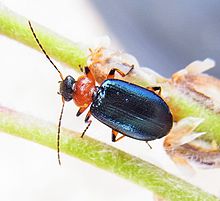Species of beetle
.mw-parser-output .hidden-begin{box-sizing:border-box;width:100%;padding:5px;border:none;font-size:95%}.mw-parser-output .hidden-title{font-weight:bold;line-height:1.6;text-align:left}.mw-parser-output .hidden-content{text-align:left}@media all and (max-width:500px){.mw-parser-output .hidden-begin{width:auto!important;clear:none!important;float:none!important))You can help expand this article with text translated from
the corresponding article in German. (June 2022) Click [show] for important translation instructions.
View a machine-translated version of the German article.
Machine translation, like
DeepL or
Google Translate, is a useful starting point for translations, but translators must revise errors as necessary and confirm that the translation is accurate, rather than simply copy-pasting machine-translated text into the English Wikipedia.
Do not translate text that appears unreliable or low-quality. If possible, verify the text with references provided in the foreign-language article.
You must provide
copyright attribution in the
edit summary accompanying your translation by providing an
interlanguage link to the source of your translation. A model attribution edit summary is Content in this edit is translated from the existing German Wikipedia article at [[:de:Lebia cyanocephala]]; see its history for attribution.
You may also add the template ((Translated|de|Lebia cyanocephala)) to the
talk page.
For more guidance, see
Wikipedia:Translation.
Lebia cyanocephala, sometimes called the blue plunderer,[1] is a ground beetle from a subfamily of Harpalinae.
Adult beetles are 7.5 millimetres (0.30 in) long. The head and elytra are metallic blue.The pronotum is orange.
Widespread in Europe but rare. The northern boundary of the distribution area goes through southern England , southern Norway , southern Sweden and southern Finland . The southern limit of the range runs through western North Africa and reaches Israel in Asia Minor . Of the Mediterranean islands, the beetle is only known from Sicily and Cyprus . The species occurs across the Palearctic to the east as far as Siberia and northern China.
Content in this edit is translated from the existing German Wikipedia article at de:Lebia cyanocephala; see its history for attribution.
|
|---|
| Lebia cyanocephala | |
|---|
| Carabus cyanocephalus | |
|---|
